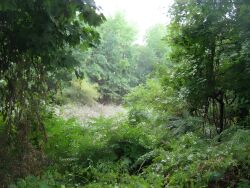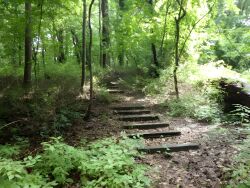Grand Central Parkway
Grand Central Parkway
The plan for New York City’s original parkway system was conceived by distinguished landscape architect Frederick Law Olmsted (1822-1903). Olmsted is best known for his work with Calvert Vaux (1824-1895); the two designed both Central Park (1858-76) and Prospect Park (1865-95), as well as Riverside (1875-1900) and Morningside Parks (1883-95). During the second half of the 19th century, Olmsted emerged as the nation’s foremost advocate of public parks situated in urban locales. The designer keenly recognized the ill effects of overcrowding in America’s cities. He attributed poor health, unsanitary conditions, and crime to the smothering effect of urban landscapes. Olmsted sought to improve the quality of urban life through the proliferation of parks, which he hoped would provide a soothing and therapeutic effect.
During the 1860s, Olmsted conceived a system of parks connected by a new type of road called a parkway. The parkways’ scenic qualities made them extensions of the parks they were connecting. To accommodate an increasing number of drivers, parkway traffic was divided according to purpose. The center roadway was reserved for private through traffic, and local and commercial vehicles were routed along parallel side roads. Landscaped greenery was used to separate the outer and inner roadways. A further deterrent to congestion was the elimination of intersections: all intersections were either bridged over or tunneled under the parkway. Among the existing parkways actually designed by Olmsted, Eastern Parkway and Ocean Parkway still fulfill their intended function.
Inspired by Olmsted, Long Island State Parks Commission Chairman Robert Moses (1888-1981) lobbied for the construction of the Grand Central Parkway in 1930. The roadway was funded in part by the New Deal public works projects of the 1930s. The thoroughfare was a component of Moses’ “great parkway plan.” Developed in 1924, the future Parks Commissioner’s plan allowed increased automobile access to the five boroughs, as well as to Westchester and Long Island. It also allowed for a closer integration of outlying city areas and unrivaled access to recreation areas. In total, the plan eventually built 16 parkways in the New York metropolitan area. The original design called for graceful masonry bridges, specimen trees, rustic wooden railings and lightpoles, and sweeping landscapes.
This parkway’s construction began in July 1931, following a ceremony led by Governor Franklin D. Roosevelt and Robert Moses. Construction took place in two stages with the first section (Queens Boulevard to Nassau County Line) being completed in July 1933. In 1936, builders completed the second section, which extends from the Interborough Parkway to the Triborough Bridge. In the same year, the Interborough and Laurelton Parkways were completed, along with the Triborough Bridge. The Grand Central Parkway now extends from the Triborough Bridge to the Northern State Parkway, forming a contiguous link between the Bronx, Manhattan, and Long Island. Spanning 14.6 miles, the thoroughfare’s construction cost over $12 million.
During the late 1950s, due to the exponential growth of auto traffic, Robert Moses recognized the need to expand the Grand Central Parkway’s capacity and efficiency. In 1959, Moses announced a $40 million reconstruction, featuring the expansion of the Astoria to Kew Gardens section from six to eight lanes, and the Kew Gardens to Glen Oaks section from four to six lanes. Other improvements included median separation, wider shoulders, and the introduction of acceleration and deceleration lanes. The parkway now accommodates over 130,000 vehicles per day.
Parks acquired the parkway on June 1, 1937, via a resolution from the Board of Estimate. The decision placed the roadways, adjacent landscaped areas, and service roads under the department’s jurisdiction. In 1983, the Leventhal Agreement (named for former Deputy Mayor of Operations Nathan Leventhal) transferred maintenance responsibility for a number of arterial highways, including the Grand Central Parkway, to the Department of Transportation.
Check out your park's Vital Signs
Clean & Safe
Green & Resilient
Empowered & Engaged Users
Share your feedback or learn more about how this park is part of a
Vital Park System




